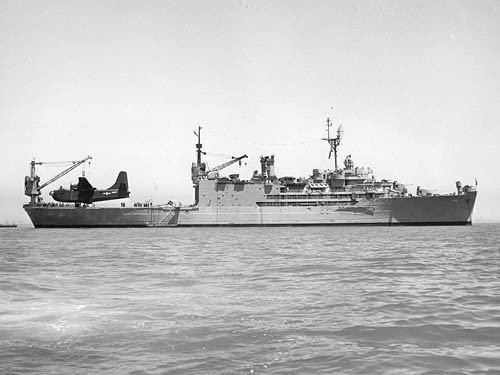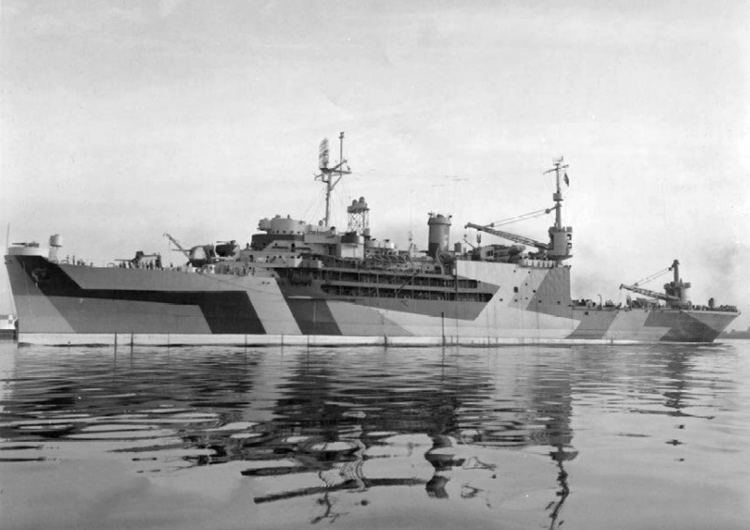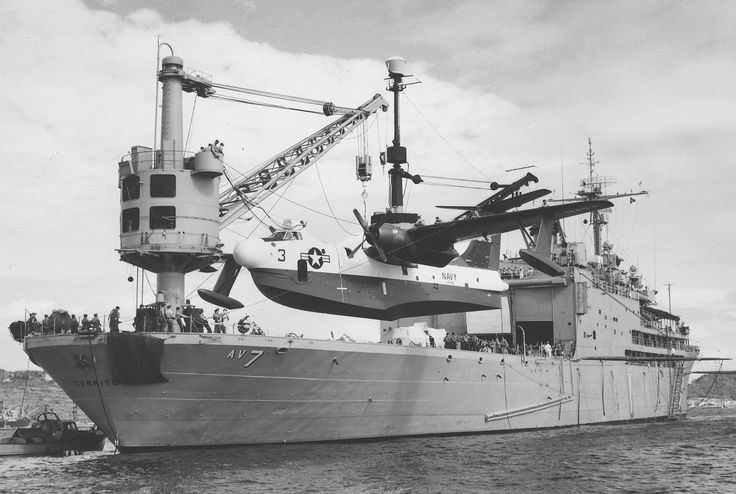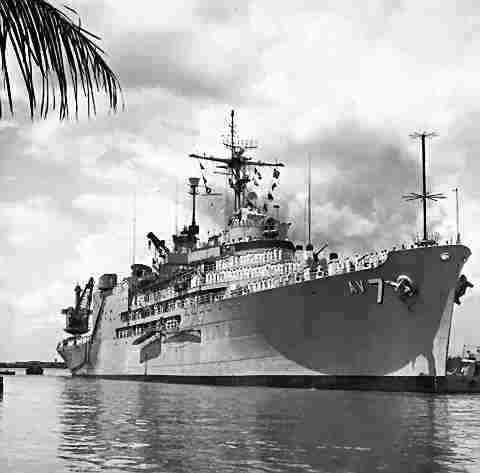Name USS Currituck Builder Philadelphia Navy Yard Commissioned 26 June 1944 Construction started 14 December 1942 Length 165 m | Laid down 14 December 1942 Decommissioned 31 October 1967 Launched 11 September 1943 Displacement 12.7 million kg | |
 | ||
USS Currituck (AV-7) was the first of four Currituck class seaplane tenders, and was nicknamed the Wild Goose. She was built during World War II and served during the Cold War.
Contents

The second US ship to be named for the Currituck Sound, the Currituck (AV-7), was launched 11 September 1943 by Philadelphia Navy Yard; sponsored by Mrs. M. F. Draemel; and commissioned 26 June 1944, Captain W. A. Evans in command.

World War II Service

Currituck put to sea from Philadelphia on 31 August 1944 bound for duty with the Pacific Fleet. At Balboa, Panama, she embarked passengers for transportation to Manus, then continued on to Mios Woendi to unload cargo. She carried men and airplane spare parts and supplies for USS Tangier (AV-8) from Manus to Morotai, then returned to Mios Woendi briefly before arriving in San Pedro Bay, Leyte, 6 November to begin tending seaplanes flying missions in the Leyte operations.

Currituck sailed from Leyte on 6 January 1945 for the initial landings at Lingayen Gulf, Luzon, three days later, and remained there, at Cabalitan Bay, and at Mindoro tending seaplanes and directing seaplane search operations. She returned to Leyte 5 February, then sailed for Manila on 3 March. Upon her arrival three days later she sent boarding parties to inspect abandoned Japanese vessels in the harbor. Her tender duties at this port included maintenance of the 76th Wing of the Royal Australian Air Force from 27 April to 6 May.
Departing Manila 10 June 1945 Currituck maintained a base for seaplanes conducting night searches from Lingayen Gulf between 11 June and 20 August, then returned to Manila 24 August. She sailed for Okinawa on 30 August.
Currituck remained in the Far East in support of the reoccupation of the Chinese mainland, tending seaplanes at Jinsen (Inchon), Korea, and Shanghai, Tsingtao, and Taku, China, returning to Okinawa 28 October. She got underway for the United States on 9 December and arrived at San Francisco 30 December.
Post World War II 1940s service
In 1946, the Currituck and the USS Pine Island served in the Antarctic expedition Operation Highjump.
After operations from this port and San Diego, she sailed 2 December 1946, touched at the Marquesas Islands and visited Sydney, Australia, from 13 to 20 March 1947. She returned by way of the Panama Canal to Norfolk, Va., arriving 18 April. Currituck was placed out of commission in reserve 7 August 1947, berthed at Philadelphia.
1950s
Recommissioned 1 August 1951, Currituck got underway 17 December for Norfolk. From this port she operated locally and in the Caribbean, primarily on training duty. She departed Norfolk 23 August 1952 for a cruise which included visits to Thoneim, Norway, and Leith, Scotland, returning to her home port 17 October. After local operations and a brief voyage to Bermuda, she sailed again from Norfolk 24 August 1953, passing through the Panama Canal for operations around the Galápagos Islands, and returning to Norfolk 25 September. On 6 July 1954 she cleared for a European cruise, calling at Milford Haven, Wales, continuing to Taranto, Italy, and touching again at Milford Haven and Portsmouth before returning to Norfolk 18 September.
Between 26 August and 13 December 1956 Currituck served with the US 6th Fleet in the Mediterranean, returning to training cruises to the Caribbean and local operations at Norfolk until 9 January 1958 when she entered the Philadelphia Naval Shipyard.
1960–1964
USS Currituck was re-commissioned on 20 August 1960, with Captain Cecil A. Bolam, USN, as Commanding Officer, and Commander G. L. Bliss, USN as Executive Officer, and following a shakedown and training cruise along the East Coast and Caribbean, steamed through the Panama Canal to her new home port of San Diego, California, arriving on 3 December 1960.
In early June 1961 Captain Cecil A. Bolam, USN was replaced, as Commanding Officer, by Captain Waller Clarke Moor, USN.
On a pre-deployment exercise USS Currituck operated with VP-42, attached to NAS North Island, for two days at a seadrome established at White Cove, Santa Catalina Island, California. VP-42 was operating nine P5M’s.
USS Currituck deployed to the Western Pacific on 27 June 1961 on her first tour where she served as Flagship for Commander, Taiwan Patrol Force, Rear Admiral Bernard M. Strean, USN. This force, comprising both air and surface patrol, provided surveillance patrols along the coast lines of Soviet Siberia, North Korea, North Vietnam and the Communist held China Mainland.
Captain Robert Wilks Windsor, Jr., USN. In a warm-up cruise, prior to her next West-Pac deployment, USS Currituck made an Alaskan voyage that spanned the Aleutian Islands, operating with VP-47 equipped with P5M Marlin seaplanes. USS Currituck, on this operation, provided the rare opportunity to visit the port of Anchorage, Alaska, and became the largest ship ever to visit that port. Fifty hours at a buoy were logged by VP-47 Commanding Officer Commander Dow and his crew. They and a storm arrived at Cold Bay at the same time. Transfer to Currituck by small boat was impossible.
Prior to deployment the crew of USS Currituck said good bye to Chief Aviation Machinist Mate Otto Keller. Chief Keller was at the time the senior Chief in the US Navy, having joined the Navy in 1908. The Secretary of the Navy participated in Chief Keller's retirement ceremony.
Captain O. B. Gray, USN reported on board as Executive office in August 1962. USS Currituck began her second West-Pac tour on 26 October 1962. The ship arrived in Yokosuka, Japan on 11 November 1962 when she again took on Commander, Taiwan Patrol Force, Rear Admiral Bernard M. Strean. She sailed for Buckner Bay, Okinawa on 17 November 1962. After two days at sea lookouts sighted the Japanese fishing vessel Seiyu Maru which had been damaged in a typhoon, and without power. USS Currituck took her in tow and passed food and clothing to her crew. After a night of careful watch she was transferred to a Japanese rescue vessel and USS Currituck steamed on to Okinawa, where she arrived on 20 November 1962 at her new “Home Port” of White Beach.
On 1 December 1962 the Flag changed command. Rear Admiral Robert Anthony Macpherson, USN took Command as Commander, Patrol Force Seventh Fleet - Commander, Fleet Air Wing One - Commander, Taiwan Patrol Force - Commander, Task Force 72.5. USS Currituck remained at White Beach until 3 December 1962, when she departed for Cebu, Philippines.
USS Currituck arrived in Cebu, Philippines on 6 December 1962 where, after intensive day and night seaplane operations with VP-40 from Sangley Point (Naval Air Station), Cavite City, Philippines, she departed on 10 December 1962 for Manila Bay. USS Currituck dropped anchor off Sangley Point on 12 December 1962 and remained until 15 December 1962.
On 18 December 1962 USS Currituck arrived back in Buckner Bay, Okinawa where she tied up to pier "Bravo" at White Beach. The Surrey Singers from Oklahoma City University entertained on board. A few members of the crew were lucky enough to see Bob Hope and his Troupe entertain at the US Army's Stillwell Field House on 23 December 1962. The crew had a Christmas party for Okinawan children, but it appeared that the sailors may have had the most fun. Both Protestant and Catholic Christmas services were held on Board. USS Currituck's Chaplain, Lieutenant W. A. Stewart, USN conducted the Protestant services. USS Currituck departed on 7 January 1963 for Manila.
Arriving in Manila Bay, Philippines on 10 January 1963, for a seven-day stay. One of the highlights of this visit was the tour of the Isle of Corregidor, with the Barracks as a grim reminder of the event that occurred here during World War II. USS Currituck departed Manila Bay on 16 January 1963 bound for Buckner Bay.
USS Currituck arrived in Buckner Bay, Okinawa on 19 January 1963 where she remained until 11 February 1963. This stay saw two change of commands. Captain Windsor was replaced by Captain Gray, and then Captain Gray was replaced by Captain Paul J. Knapp, USN with Captain Gray returning to his previously held position as Executive Officer.
En route to Hong Kong, USS Currituck stopped off at Koshsiung, Taiwan on 13 February 1963 where the visit was highlighted by the Seven Seas from Tsoying Naval Base who entertained the crew with a variety show. Than at sea again on 15 February 1963 and arriving in Hong Kong on 16 February 1963. Mary Soo’s girls took on the job of painting some of the ship while the crew set about seeing the Tiger Balm Gardens, Sanpan Village at Aberdeen, and a seven-course Chinese dinner at the Tai Pak. On 22 February 1963 USS Currituck sailed, once again, for White Beach.
25 February 1963 saw USS Currituck back at Pier "Bravo", White Beach, Okinawa. On the morning of 9 March 1963 the crew awoke to see one of the seaplanes with its starboard wing and engine completely under water. The V-Divisions set about the rescue work, loaded the plane on board, and on 10 March 1963 steamed for Kobe, Japan. USS Currituck arrived in Kobe, Japan on 12 March 1963, offloaded the damaged plane and got under way the same day, to pick up another downed plane of VP-50 in Ominato, Japan. USS Currituck arrived in snow-covered Ominato, Japan on 16 March 1963, found the plane and some cold aviators, and another hoisting. With the plane and crew safely on board USS Currituck departed the same day.
After a transit of the Shimonoseki Straits USS Currituck arrived in Iwakuni, Japan on 19 March 1963. While in Iwakuni the crew visited neighboring Hiroshima where they visited the Castle and Ground zero, the spot where the first Atomic Bomb hit Japan. Underway on 23 March 1963 USS Currituck arrived at Yokosuka, Japan on 25 March 1963. On 1 April 1963 the USS PINE ISLAND (AV-12) arrived, and the flag was transferred. On 2 April 1963 USS Currituck departed West-Pac for her home port of San Diego, California, arriving on 19 April 1963.
June 1963 saw USS Currituck operating from a seadrone at White Cove, Santa Catalina Island, California for one week of day and night seaplane operations with VP-48.
In July 1963 Commander Brown, USN assumed duties of Executive Officer.
On 20 January 1964 Captain John W. Crowe, USN assumed command of USS Currituck.
USS Currituck began her third West-Pac tour departing San Diego on 26 January 1964. After 23 days of steaming she arrived in Naha, Okinawa on 18 February 1964. Operating in Lingayen Gulf in exercise "Minute Hand", the location of her seadrone in January 1945, some twenty year’s prior, this time servicing VP-48. Returning to Manila she participated in exercise "LIGTAS", a seven nation, seventy-five ship Task Force with massive amphibious/airborne exercises, during which USS Currituck served as Command Information Center. Next was a visit to Saigon, South Vietnam, wherein she had to navigate up the Saigon River through hostile territory. Arriving off Saigon, she negotiated a 180 degree turn by making a planned maneuver of running her bow aground on the river bank and swinging her stern upstream until she had reversed herself. Following her assigned duties in West-Pac USS Currituck returned to her home port of San Diego, California.
1965-1971 and fate
USS Currituck deployed for a subsequent West-Pac cruise on 23 April 1965 to become Flagship Patrol Force Seventh Fleet. After visits to Koh Samui and Bangkok, Thailand she established a seadrome off of Con Son, Poulo Condores Islands, Republic of Viet Nam on 29 May 1965 and began servicing aircraft of VP-40. During this period USS Currituck established a number of firsts. On 22 June 1965, USS Currituck became the first ship of her class to deliver shore bombardment against enemy positions in the Mekong Delta region of Vietnam. She also established a record sixty-seven days on continuous seaplane operations in Cam Rahn Bay, South Viet-Nam, an advanced-base area. Upon leaving Vietnam, she visited Hong Kong, British Crown Colony; Keelung and Kaohsiung, Taiwan; Yokosuka, Sasebo and Kobe, Japan; Subic Bay, Zambales, Philippines. When not at Buckner Bay operating with VP-50. The ship commanded by Captain Martin G. O’Neill, USN and Commander Keith E. Bailey, USN served as Executive Officer.
USS Currituck returned to San Diego on 1 December 1965 and on 13 January 1966 departed for a two-week training cruise with stops at Magdelina Bay and La Paz, Mexico, returning to San Diego on 27 January. Captain Wayne G. Hammett took command of the USS Currituck on 11 February 1966. Commander William W. McCue had reported as Executive Officer in December 1965. She also Flew the Flag at the Maritime Festival, Vancouver, British Columbia, Canada. Seadrome operations were also conducted in the vicinity of Santa Catalina Island, California on several occasions.
USS Currituck’s final deployment to West-Pac reduced her six month homeport stay four months and she left for operations from a seadrome at her anchorage in Cam Rahn Bay, South Vietnam where she serviced the P5M’s (SP5's) of VP-40 during Operation Market Time. Operating from USS Currituck, VP-40 participated in the last seaplane tender operations conducted by the U.S. Navy and closed this phase of U.S. Naval Aviation History after operating there from 19 March to 12 April 1967. VP-40 logged a total of 860 flight hours, utilizing but seven aircraft from USS Currituck, which maintained an availability of 94.38%. While operating with the Mobil Riverine Force in Vietnam USS Currituck’s call sign was "Flying Goose" On 23 May 1967, USS Currituck returned to her home port of San Diego, California and in so doing brought down the curtain on one of the more colorful facets of Naval Aviation operations. She was the last active seaplane tender in the U. S. Navy.
After twenty-one days back in her home port in late June 1967, USS Currituck steamed to Seal Beach, California for weapons offload, then to Mare Island at Vallejo, California for decommissioning. She was later towed to Puget Sound Naval Shipyard, Bremerton, Washington. There she joined her remaining class members, and West-Pac sisters; USS Pine Island (AV-12) and USS Salisbury Sound (AV-13) already in the same status. She was decommissioned for the last time on 31 October 1967 and laid up in the Pacific Reserve Fleet in Vallejo, CA. She was struck from the Naval Register on 1 April 1971 for disposal, and from the Naval Records on 1 January 1972. She was sold to Union Minerals, and dismantled at Learner Shipyard, Oakland, California in June 1972.
Today one of USS Currituck’s propellers can be seen as the basis of the 'Passing on the Tradition' memorial located on the Louis Memorial Boardwalk in Bremerton WA.
